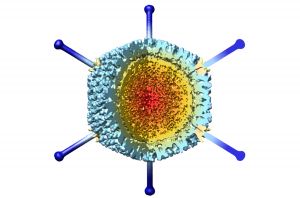La cápsula de proteínas que contiene y protege el genoma de los adenovirus está formada por más de diez tipos de proteínas, que deben producirse y ensamblarse de forma muy coordinada. El ensamblaje de esta cápsula (o cápsida) y la introducción del genoma en su interior debe ser correcto para que el virus pueda propagarse. Para introducir el genoma dentro de la cápsida existen dos tipos de mecanismos: concertado, en que la cápsula de proteínas se construye en torno al genoma, o secuencial, donde primero se ensambla una cápsida vacía con un canal por el que luego entra el genoma. Aunque los adenovirus se llevan estudiando más de 60 años, no se conocían dos aspectos básicos de su biología: dónde se lleva a cabo el ensamblaje, y mediante cuál de los dos mecanismos se lleva a cabo.
Ahora, un estudio realizado por investigadoras del Consejo Superior de Investigaciones Científicas (CSIC) y publicado en PLOS Pathogens ha localizado la región celular donde se forman los adenovirus, e indica que el ensamblaje de la cápsida y la entrada del genoma en su interior se lleva a cabo de forma concertada. El hallazgo puede contribuir tanto a diseñar posibles medicinas (antivirales) para el tratamiento de enfermedades producidas por adenovirus, como para diseñar nuevos virus que puedan servir como herramientas terapéuticas.
Las investigadoras Carmen San Martín y Gabriela Condezo, del Centro Nacional de Biotecnología (CSIC), que han realizado el estudio, explican que “en la célula infectada, la formación de nuevos virus se produce en localizaciones específicas donde coinciden en el espacio y el tiempo las proteínas que formar la cápsida y los genomas, llamadas “factorías virales”.
En este trabajo se han empleado técnicas de inmunofluorescencia e inmunomicroscopía electrónica, que “nos han permitido determinar en qué parte de la célula coinciden las proteínas de la cápsida y el genoma de adenovirus; es decir, hemos localizado la factoría viral”, indican las investigadoras. “Además, mostramos por primera vez imágenes con fragmentos de cápsida de distintos tamaños unidas a estructuras formadas por el genoma del virus y unas proteínas que ayudan a condensarlo para que quepa dentro de la cápsida. Estas imágenes apoyan el modelo de ensamblaje concertado más que el secuencial, que era el más aceptado.”
La infección por adenovirus es común en seres humanos, y aunque no tiene en general gran relevancia clínica (en condiciones normales, puede producir síntomas similares a los de un catarro leve), sí puede ser grave en el caso de pacientes inmunodeprimidos (por ejemplo, niños a los que se les ha practicado un trasplante de órganos).
Una herramienta contra los tumores
“Existe un amplio campo de investigación sobre el posible uso de adenovirus como vector terapéutico, de forma que la capacidad de infectar del virus se traduzca en un beneficio para el paciente. Por ejemplo, se estudia la posibilidad de modificar el virus de forma que sólo destruya a las células de los tumores, y no a las células sanas”, explica San Martín.
Tanto para diseñar posibles medicinas (antivirales) para el tratamiento de enfermedades producidas por adenovirus, como para diseñar nuevos virus que puedan servir como herramientas terapéuticas, es imprescindible conocer con el mayor grado de detalle posible cómo se forma la partícula viral, advierte la investigadora.
“Además, la información acerca del ensamblaje de adenovirus puede servir de modelo para comprender cómo se ensamblan otros virus aún más complejos. Por ejemplo, el virus de la peste porcina africana o los virus gigantes como el mimivirus. Esto se debe a que todos estos virus, a pesar de infectar organismos diferentes, construyen sus cápsidas con proteínas muy parecidas en estructura”, concluye San Martín.
- Fuente CSIC Comunicación
- Gabriela N. Condezo and Carmen San Martín. Localization of Adenovirus Morphogenesis Players, together with Visualization of Assembly Intermediates and Failed Products, Favor a Model where Assembly and Packaging Occur Concurrently at the Periphery of the Replication Center. PLOS Pathogens. Doi: 10.1371/journal.ppat.1006320






